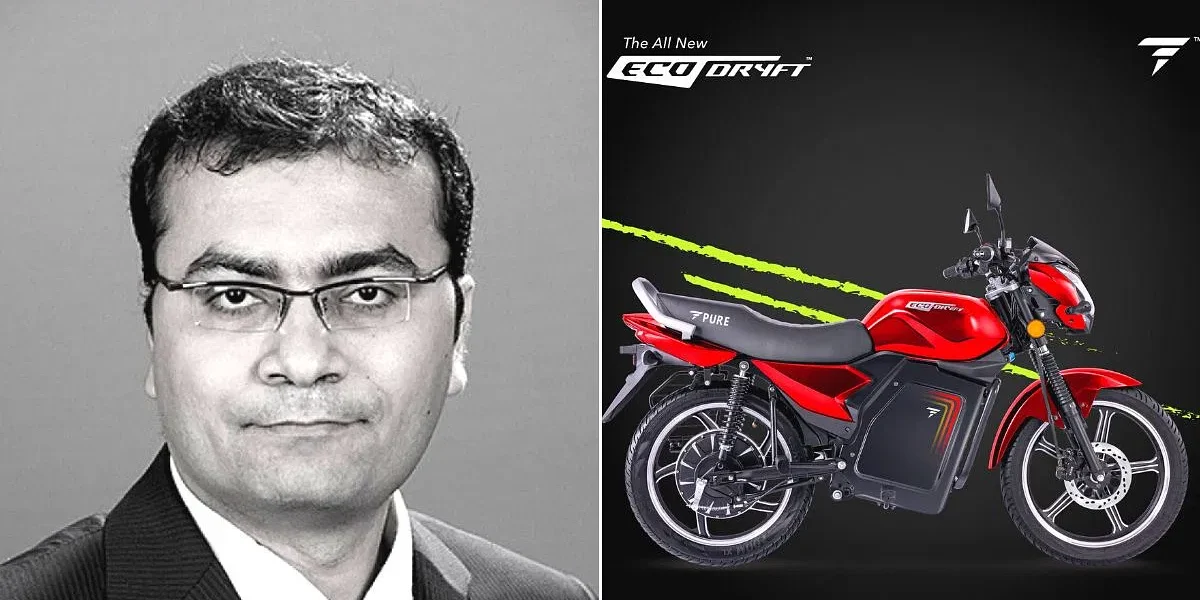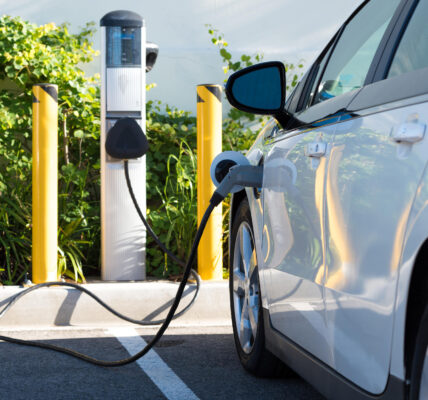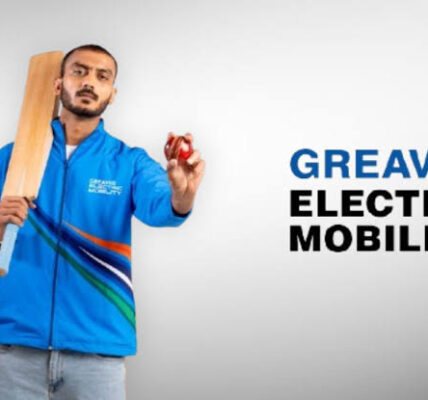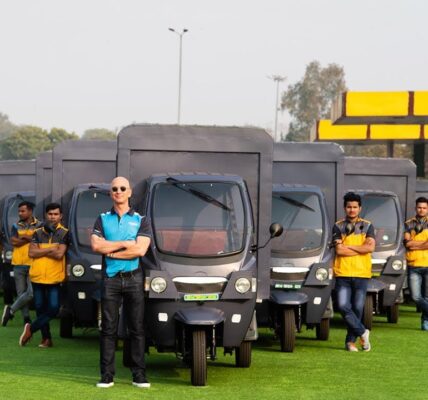PURE EV, a Hyderabad-based electric vehicle (EV) two-wheeler venture, is on the cusp of launching its first electric motorcycle for the commuter segment called the ecoDryft.
Dr Nishanth Dongari, founder of PURE EV, claims, “The average Indian consumer relies on a commuter motorcycle (75cc–125cc segment in IC-engine motorcycle terms) as his daily driver. Commute motorcycles make up about 50% of all two-wheeler sales in India. Currently, there are no other electric motorcycles available for Indian consumers looking for a commuter motorcycle as their daily driver.”
“The entire product engineering has been done to provide a reliable and comfortable ride experience even at 75 kmph on par with IC-engine motorcycles. This is also a demonstration of PURE EV’s learnings in the powertrain design and development at our R&D centre,” he adds.
The ecoDryft has been designed and developed at PURE EV’s technical and manufacturing centre in Hyderabad. The e-motorcycle boasts a top speed of 75 kmph and a single full charge will provide a range of up to 135 km, claims the company. The vehicle is powered by a 3.0 KWH patented and AIS (Automotive Indian Standard) 156-certified battery, developed by PURE EV.
“The all-new ecoDryft is also powered by a Brushless DC (BLDC) motor that generates a peak power of 3 KW and a nominal power of 2 KW with greater than 90% efficiency. Even the controller for the motor is run by our in-house developed algorithm that ensures the most efficient and optimum power output,” explains Dr Dongari, who is also an associate professor at the Department of Mechanical and Aerospace Engineering, IIT Hyderabad.
“We have been carrying out extensive trials and testing for this product and are confident that the product will deliver highly competitive performance with respect to the existing range of IC-engine motorcycles and will be another step in the direction of switching customers towards EVs. This e-motorcycle is a game changer not only for the company but also for the country’s EV adoption vision,” he adds.
Going further, the ecoDryft comes with a semi-portable battery pack.
“The vehicle can be plugged into a standard three-pin power socket, and it takes three hours to charge from 20% to 80%. Normally, a 3 KWH battery consumes three units of electricity. For example, if the unit cost of electricity is Rs 8, then the average cost per kilometre would be around 25 paise which is less than 20% of the cost per kilometre compared to a petrol-powered commuter motorcycle,” he explains.
“We design, develop and manufacture all of our battery packs in-house. The new generation battery packs from PURE are smarter and safer compared to the earlier generation along with being compliant with the strictest new AIS 156 battery standards,” says Dr Dongari.
A key aspect of this EV is the “patented and AIS 156 certified battery, which is designed to work efficiently under tough environmental conditions”, which gives the e-motorcycle “the capability to adapt to different Indian terrains,” notes a recent press release issued by PURE EV.
But given recent concerns around EVs catching fire, how is PURE EV addressing them?
It begins with state regulation. “The new regulatory standards for the batteries — AIS 156 — is a welcome step that the government has taken to enhance the safety norms. These new standards will ensure that all the battery packs going forward comply with the stringent new norms and are certified by the testing agencies. This will take care of the key safety issue that has become a huge deterrent for EV adoption in India,” argues Rohit Vadera, co-founder and CEO of PURE EV.
But the answer also lies in their own R&D centre in Hyderabad. “As electric two-wheeler OEMs in India that manufacture their own battery packs, we have a lot of freedom to imbibe our well-researched, proven and tested technologies into the battery packs that we manufacture. We have multiple patents and filings when it comes to our proprietary battery packs and the algorithm that runs the BMS (battery management system),” explains Dr Dongari.
“As mentioned earlier, the latest generation Smart BMS along with our proprietary technology adds additional layers of safety to our already safe battery packs,” he adds.
In terms of sourcing, Vadera claims that PURE EV meets “100% of the battery localisation norms issued by the government” while a majority of the sub-components are sourced from domestic Tier 1 suppliers. Meanwhile, “the new generation battery packs are also equipped with micro-controller based Smart BMS with CAN-bus protocols,” he adds.
The EV battery pack designed and developed in-house also has “multiple protection features like charging protection, discharge protection, overcurrent protection, short circuit protection, temperature protection, and voltage protection,” says Dr Dongari. “They have been further enhanced compared to the earlier generation ones. Also, PURE EV’s battery packs use our in-house designed algorithm for the BMS that adds an additional layer of safety and performance,” he adds.
Initially, PURE EV started with scooters, but their long-term ambition has always been to get into motorcycles. Last year, they were able to launch a premium segment e-motorcycle — The Silent Beast: eTryst 350 — and received a strong response from the customers.
“So, adapting the engineering and design strengths of eTryst 350 towards a commute-friendly segment was the next logical step for us. The eTryst 350 (The Silent Beast) is a premium motorcycle that comes with a bigger powertrain (battery and motor). It offers a higher range and a higher top speed compared to the ecoDryft, which is specifically designed keeping in mind the huge two-wheeler commute segment of India. Even aesthetically, both the products look very different as they both target different demographics,” says Vadera.
However, the biggest challenge in building the ecoDryft was developing a powertrain that is suited for the rugged Indian conditions, terrain and temperature. “Motorcycles have a bigger battery pack and motor than scooters, so the workload on the power train is more pronounced. The most optimum and efficient powertrain is critical and crucial when it comes to a commuter motorcycle as it needs to be reliable. We have tested it extensively and rigorously across multiple conditions and are happy with the results,” claims Dr Dongari.
Highlighting PURE EV’s plans, Rohit Vadera, said earlier this week, “Going forward, we will be focusing more on brand building and launching newer versions of the existing product portfolio. The vehicle will be highly competitive on a Total Cost of Ownership (TCO) basis for the average consumer who uses a commuter motorcycle.”
“We are consistently working on upgrading our sales and after-sales service network which is the key requirement to sustain higher sales and brand loyalty across the automobile industry. PURE EV has over 100 premium dealership outlets across India,” he adds.
At present, the company has deployed demo vehicles for test drives across its outlets in PAN India. Also, the pricing will be revealed in the first week of January 2023, and it will be available in four color variants — black, grey, blue and red. Through the launch of this e-motorcycle, PURE EV is looking to not only expand its footprint in India but also in South Asia, South America and Africa.







